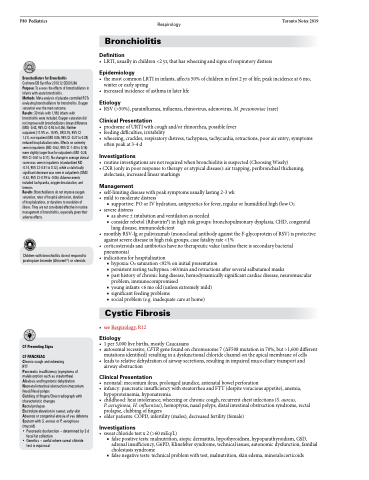Page 1114 - TNFlipTest
P. 1114
P80 Pediatrics
Respirology
Toronto Notes 2019
Bronchodilators for Bronchiolitis
Cochrane DB Syst Rev 2010;12:CD001266 Purpose: To assess the effects of bronchodilators in infants with acute bronchiolitis.
Methods: Meta-analysis of placebo-controlled RCTs evaluating bronchodilators for bronchiolitis. Oxygen saturation was the main outcome.
Results: 30 trials with 1,992 infants with bronchiolitis were included. Oxygen saturation did not improve with bronchodilators (mean difference (MD) -0.43, 95% CI -0.92 to 0.06). Neither outpatient (11.9% vs. 15.9%, OR 0.75, 95% CI
1.21). nor inpatient (MD 0.06, 95% CI -0.27 to 0.39) reduced hospitalization rates. Effects on oximetry seen in inpatients (MD -0.62, 95% CI -1.40 to 0.16) were slightly larger than for outpatients (MD -0.25, 95% CI -0.61 to 0.11). No change in average clinical score was seen in inpatients (standardized MD -0.14, 95% CI -0.41 to 0.12), while a statistically significant decrease was seen in outpatients (SMD -0.42, 95% CI -0.79 to -0.06). Adverse events included tachycardia, oxygen desaturation, and tremors.
Results: Bronchodilators do not improve oxygen saturation, rates of hospital admission, duration
of hospitalizations, or durations to resolution of illness. They are not considered effective in routine management of bronchiolitis, especially given their adverse effects.
Children with bronchiolitis do not respond to ipratropium bromide (Atrovent®) or steroids
Bronchiolitis
Definition
• LRTI,usuallyinchildren<2yr,thathaswheezingandsignsofrespiratorydistress
Epidemiology
• themostcommonLRTIininfants,affects50%ofchildreninfirst2yroflife;peakincidenceat6mo, winter or early spring
• increasedincidenceofasthmainlaterlife
Etiology
• RSV(>50%),parainfluenza,influenza,rhinovirus,adenovirus,M.pneumoniae(rare)
Clinical Presentation
• prodromeofURTIwithcoughand/orrhinorrhea,possiblefever
• feeding difficulties, irritability
• wheezing,crackles,respiratorydistress,tachypnea,tachycardia,retractions,poorairentry;symptoms
often peak at 3-4 d
Investigations
• routineinvestigationsarenotrequiredwhenbronchiolitisissuspected(ChoosingWisely)
• CXR (only in poor response to therapy or atypical disease): air trapping, peribronchial thickening,
atelectasis, increased linear markings
Management
• self-limiting disease with peak symptoms usually lasting 2-3 wk • mildtomoderatedistress
■ supportive: PO or IV hydration, antipyretics for fever, regular or humidified high flow O2 • severedistress
■ as above ± intubation and ventilation as needed
■ consider rebetol (Ribavirin®) in high risk groups: bronchopulmonary dysplasia, CHD, congenital
lung disease, immunodeficient
• monthlyRSV-Igorpalivizumab(monoclonalantibodyagainsttheF-glycoproteinofRSV)isprotective
against severe disease in high risk groups; case fatality rate <1%
• corticosteroidsandantibioticshavenotherapeuticvalue(unlessthereissecondarybacterial
pneumonia)
• indicationsforhospitalization
■ hypoxia: O2 saturation <92% on initial presentation
■ persistent resting tachypnea >60/min and retractions after several salbutamol masks
■ past history of chronic lung disease, hemodynamically significant cardiac disease, neuromuscular
problem, immunocompromised
■ young infants <6 mo old (unless extremely mild) ■ significant feeding problems
■ social problem (e.g. inadequate care at home)
Cystic Fibrosis
• seeRespirology,R12
Etiology
• 1per3,000livebirths,mostlyCaucasians
• autosomalrecessive,CFTRgenefoundonchromosome7(ΔF508mutationin70%,but>1,600different
mutations identified) resulting in a dysfunctional chloride channel on the apical membrane of cells • leads to relative dehydration of airway secretions, resulting in impaired mucociliary transport and
airway obstruction
Clinical Presentation
• neonatal:meconiumileus,prolongedjaundice,antenatalbowelperforation
• infancy:pancreaticinsufficiencywithsteatorrheaandFTT(despitevoraciousappetite),anemia,
hypoproteinemia, hyponatremia
• childhood:heatintolerance,wheezingorchroniccough,recurrentchestinfections(S.aureus,
P. aeruginosa, H. influenzae), hemoptysis, nasal polyps, distal intestinal obstruction syndrome, rectal
prolapse, clubbing of fingers
• older patients: COPD, infertility (males), decreased fertility (female)
Investigations
• sweatchloridetestx2(>60mEq/L)
■ false positive tests: malnutrition, atopic dermatitis, hypothyroidism, hypoparathyroidism, GSD,
adrenal insufficiency, G6PD, Klinefelter syndrome, technical issues, autonomic dysfunction, familial
cholestasis syndrome
■ false negative tests: technical problem with test, malnutrition, skin edema, mineralocorticoids
CF Presenting Signs
CF PANCREAS
Chronic cough and wheezing
FTT
Pancreatic insufficiency (symptoms of malabsorption such as steatorrhea)
Alkalosis and hypotonic dehydration
Neonatal intestinal obstruction (meconium ileus)/Nasal polyps
Clubbing of fingers/Chest radiograph with characteristic changes
Rectal prolapse
Electrolyte elevation in sweat, salty skin Absence or congenital atresia of vas deferens Sputum with S. aureus or P. aeruginosa (mucoid)
• Pancreatic dysfunction – determined by 3 d
fecal fat collection
• Genetics – useful where sweat chloride
test is equivocal


